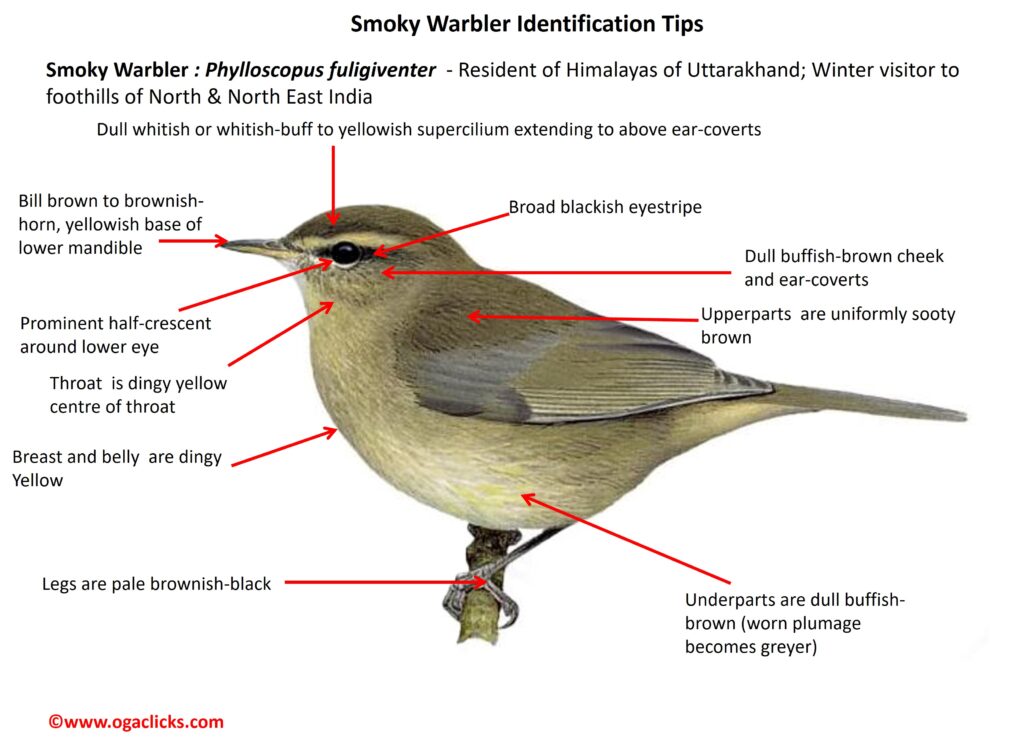
Smoky Warbler Phylloscopus fuligiventer
Etymology:
- Phylloscopus: Greek word phullon – leaf; skopos – seeker
- Fuligiventer: Latin word fuligo– soot; venter – belly
Vernacular Names: Tibetan: Chinteb-tok
Sub Species :
- Nominate – Resident of Himalayas of Uttarakhand, Winter visitor to foothills of North & North East India.
- f. tibetanus– Winter visitor to North East India (Arunachal Pradesh and North Assam).{Darker brown on upperparts and greyer or whiter on supercilium and underparts}
- f. weigoldi– Winter visitor to Himalayan foothills of North East India (Arunachal Pradesh, Assam). {Darker brown upperparts than nominate, and supercilium and underparts (including underwing-coverts) are greyish-white, belly tinged creamy}
Distribution :
- Nominate – Resident of Himalayas of Uttarakhand, Winter visitor to foothills of North & North East India.
- f. tibetanus– Winter visitor to North East India (Arunachal Pradesh and North Assam
- f. weigoldi– Winter visitor to Himalayan foothills of North East India (Arunachal Pradesh, Assam).
Details: Size of 10–11 cm. It is a small to medium-sized drab brown leaf-warbler with rather indistinct supercilium. The nominate race has dull whitish or whitish-buff to yellowish supercilium extending to above ear-coverts, prominent half-crescent around lower eye, broad blackish eyestripe, dull buffish-brown cheek and ear-coverts. The upperparts, including wing and tail, are generally uniformly sooty brown. It is dull buffish-brown below, dull or dingy yellow centre of throat, breast and belly, tinged light buff on undertail-coverts. In worn plumage becomes greyer on underparts. The iris is dark brown; bill is brown to brownish-horn, yellowish base of lower mandible; legs are brownish-black. Both the sexes are alike. Race tibetanus is darker brown on upperparts and greyer or whiter on supercilium and underparts than nominate. Race weigoldi has darker brown upperparts than nominate, and supercilium and underparts (including underwing-coverts) are greyish-white, belly tinged creamy.
Habitat: It breeds in dwarf juniper and other low-growing vegetation in rocky and boulder-strewn alpine meadows and scrub above tree-line, between 3900 m and 5000 m. In non-breeding season it is found on plains at lower levels, generally below 1000 m, where it occurs in tall grassland, dense bushes in undergrowth, and tall grass near water or along banks of small streams to fast-flowing rivers.
Food habits: It eats insects and larvae. It is usually singly or in pairs. It forages low down in vegetation or on the ground; in summer clambers among rocks and boulders, in winter often in waterside vegetation. It eats insects also while hovering briefly over water or aquatic vegetation. It skulks in thick vegetation; usually flicks wings and tail frequently.
Breeding habits: They breed in May–Aug.